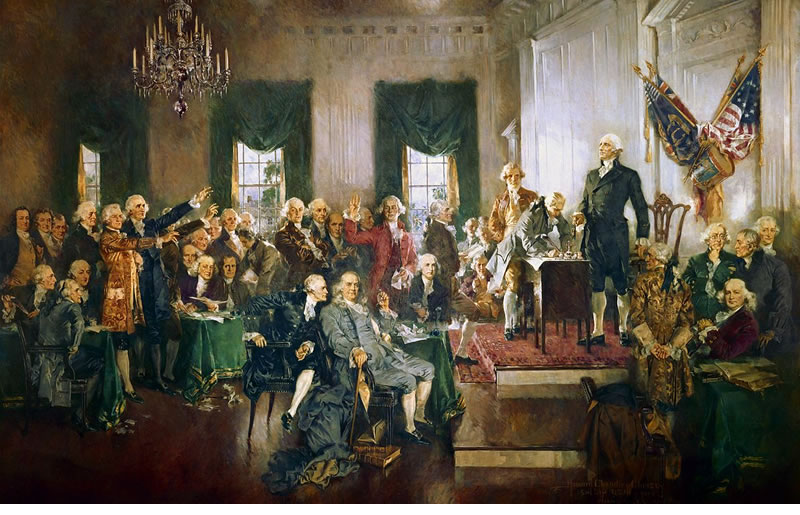
Scene at the Signing of the Constitution of the United States, a painting by Howard Chandler Christy. In the center is Benjamin Franklin (seated). Alexander Hamilton, also seated in blue, appears to be whispering in his ear. George Washington is standing by the desk. To identify other signers, click here.
By Andra Watkins, special to Charleston Currents | Most people associate Alexander Hamilton with New York, but his influence reached far beyond his adopted home state. Couple his reach with other characters from Hamilton: An American Musical on a future visit to historic Charleston, South Carolina.

Watkins
A powerhouse of early America, Charleston rivaled Manhattan in size, money and influence. Its busy port was the first point of entry for many travelers to America, from foreigners seeking a fortune in the new world to Africans wrongly enslaved. Given the flood of people and commerce, Charleston was a hub for anyone after prosperity and power.
Use this list of sights and follow characters from Hamilton on a future Charleston visit.
Alexander Hamilton
VISIT: Charleston City Hall, 80 Broad Street. Open Monday through Friday.
Alexander Hamilton never visited Charleston, but his financial policies influenced the urban fabric. Charleston City Hall was one of eight branches of The First Bank of the United States, the federal monetary arm conceived by Hamilton. Designed by Gabriel Manigault, it was completed in 1804. One can still view the vaults on the ground floor, and the banking windows are intact on the main floor.

Hamilton on the $10 bill.
Head up the stairs to visit Charleston City Council chambers, home of a unique portrait of George Washington. The city fathers commissioned a painting to honor Washington’s visit to Charleston. They chose John Trumbull for the job. When Trumbull delivered a painting of Washington on the shores of New Jersey, the city fathers were aghast. What did New Jersey have to do with Charleston? They refused to pay Trumbull for his work and demanded another painting. Washington blessed the Trumbull work hanging in Council chambers. It depicts Washington with a very naughty horse.
Aaron Burr
VISIT: The Miles Brewton House, 27 King Street
Visitors can study the impressive Miles Brewton House from the street. It isn’t open to the public, but it’s still worth a look. Built in 1765, it is a Georgian-Palladian jewel. When Aaron Burr’s daughter married into the Alston family, she relocated to Charleston and spent time in this family home. Burr gave a bust of Lafayette to the family, a gift that’s still in the house.
VISIT: The Pink House, 17 Chalmers Street
Reputed to be the oldest structure in Charleston, the Pink House was constructed around 1690. It most recently housed an art gallery, but in Aaron Burr’s day, it was a tavern with a brothel upstairs. Aaron Burr enjoyed both and likely frequented such a place when he visited his Charleston daughter.
Theodosia Burr Alston
 VISIT: The Thomas Bee House, 94 Church Street
VISIT: The Thomas Bee House, 94 Church Street
Before Theodosia disappeared at sea at the age of twenty-nine, she lived in this house with her husband Joseph Alston and their son. A deed in her name still hangs inside, and the family owns a desk attributed to her father Aaron Burr.
VISIT: The Edmonston-Alston House, 21 E. Battery Street, Thirty-minute tours. Click here for times and admission.
The Edmonston-Alston House didn’t exist in Theodosia’s day. Constructed in 1825, it is still owned by her husband’s familial descendants. The bulk of her books and papers are thought to have perished with her. The Edmonston-Alston House holds a few of Theodosia’s signed schoolbooks in their private collection and can be viewed on the longer private tour.
George Washington
VISIT: The Heyward-Washington House, 87 Church Street. More info with times and admission.
In 1791, President Washington embarked upon his Southern tour. While in Charleston, he rented the Heyward-Washington House. Constructed in 1772, it was owned by Thomas Heyward, Jr., one of the South Carolina signers of the Declaration of Independence.
VISIT: McCrady’s Tavern and the Long Room, 2 Unity Alley. Click here for lunch and dinner times.
While in Charleston, President Washington enjoyed a 30-course dinner at McCrady’s Tavern and the Long Room. Dine where he did, though perhaps on a fraction of the menu. Reservations recommended.
Marquis de Lafayette

LaFayette
VISIT: Daniel E. Huger House, 34 Meeting Street
Lafayette embarked upon a final tour of the United States from 1824 to 1825. While in Charleston, he was feted at the Daniel E. Huger House. Until 1775, it was home to the royal governor. A lawyer and politician of French descent, Huger bought the house in 1818.
Visitors can extend the tour by driving. Here are two recommended sites with Hamilton connections.
Charles Lee
VISIT: Fort Moultrie, 1214 Middle Street, Sullivan’s Island. Open daily. More info.
Charles Lee’s disastrous retreat at the Battle of Monmouth is chronicled in Hamilton. He had a habit of retreating. Before the British attacked Charleston in 1776, Lee commanded the Southern theater and was stationed at Fort Moultrie (then Fort Sullivan.) He deemed the fort “a slaughter pen” and determined to evacuate his troops to nearby Haddrell’s Point. The British started bombarding the fort before Lee could retreat.
John Laurens
VISIT: Mepkin Abbey, 1098 Mepkin Abbey Road, Moncks Corner. Open Tuesdays through Saturdays. Check website before visiting.
Hamilton’s dear friend John Laurens was born at Mepkin Plantation, now home to the monks of Mepkin Abbey. The Laurens family cemetery is located on the property. John is buried there. Visitors can tour the church and gardens, as well as apply for spiritual retreats.
Charleston resident Andra Watkins is a New York Times bestselling author and a 2015 National Book Award nominee. Her new novel, Hard to Die (reviewed here by Charleston Currents), is nominated for the 2016 National Book Award for Fiction. She is author of four books: To Live Forever: An Afterlife Journey of Meriwether Lewis (Not Without My Father: One Woman’s 444-Mile Walk of the Natchez Trace (Word Hermit Press, 2015; National Book Award nominee; NY Times best seller); Natchez Trace: Tracks in Time (Word Hermit Press, 2015); and Hard to Die (Word Hermit Press, 2016; National Book Award nominee).
Learn more about Watkins at www.andrawatkins.com and connect with her on Facebook and Twitter.
- Have a comment? Send to: editor@charlestoncurrents.com



 We Can Do Better, South Carolina!
We Can Do Better, South Carolina!
























